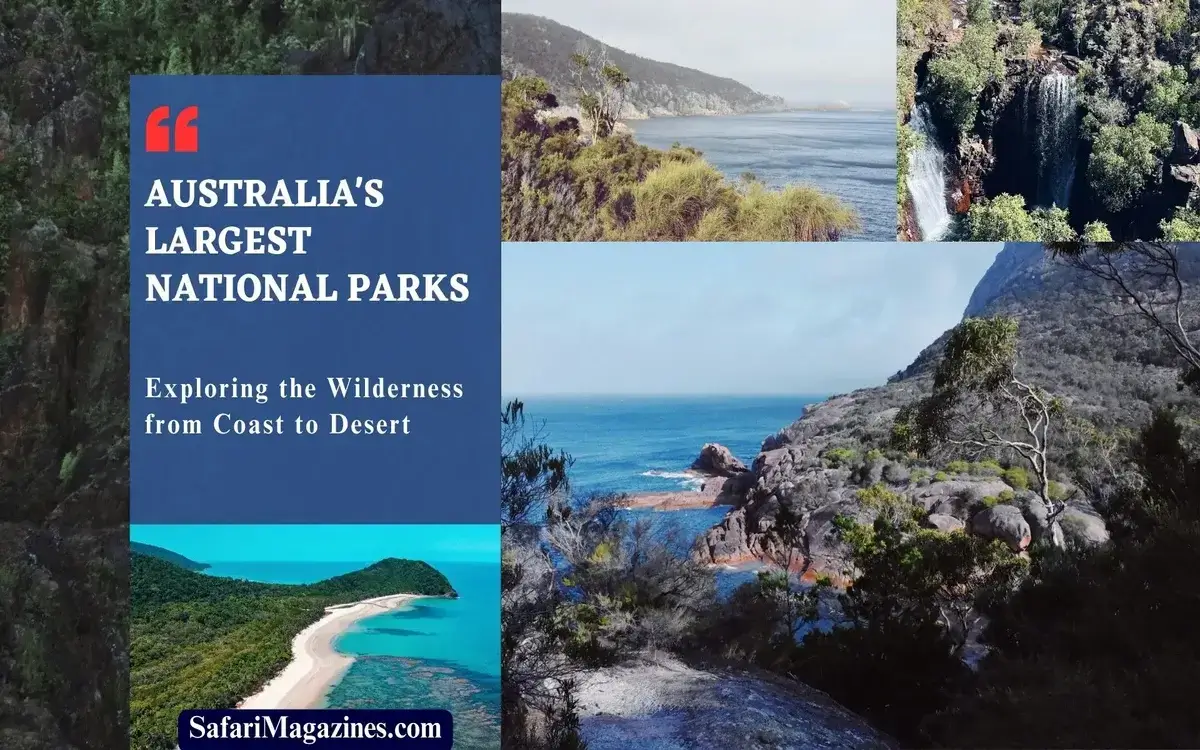
Australia’s Largest National Parks, Wilderness from Coast to Desert. Australia, Known for its stunning natural views and diverse ecosystems, is home to an amazing collection of national parks. Each of these national parks are offering a unique story of natural wonders and the country’s diverse natural heritage and each has its own charm and attractions. As a result, this vast expanse of the Australian continent are some of the world’s most stunning National Parks. From ancient rainforests to sprawling deserts, these protected areas are safe places for wildlife and havens for outdoor adventurers. Let’s discover some of Australia’s largest national parks and explore the wonders they have to offer.
Table of Contents
ToggleCriteria of Selection Australian Parks
The criteria for selecting the parks are based on several factors, including:
- Size: Each park featured in the article is one of Australia’s largest national parks, selected based on its vast expanse of protected wilderness and significant land area.
- Nature’s Variety: Each park has a different kind of nature, from green rainforests to colorful reefs, showing off Australia’s many natural wonders.
- Iconic Features and Special Sights: Each park has iconic natural features or landmarks that make it a distinct destination for visitors, such as ancient rock formations, pristine beaches, or unique wildlife that you won’t see anywhere else.
- Accessibility: Even if some parks are far away, there are still ways to get there and have an adventure, whether by road, boat, or with a guide.
- Cultural and Historical Significance: Some parks have cultural or historical significance, with Indigenous heritage sites, traditional land management practices, or historical landmarks that enrich the visitor experience and highlight Australia’s rich cultural heritage.
- Tourist Attractions: Each park is chosen for the range of activities and experiences it offers visitors, from hiking and wildlife watching to camping and snorkeling, making them popular destinations for nature lovers and outdoor enthusiasts alike.
Munga-Thirri Simpson Desert National Park
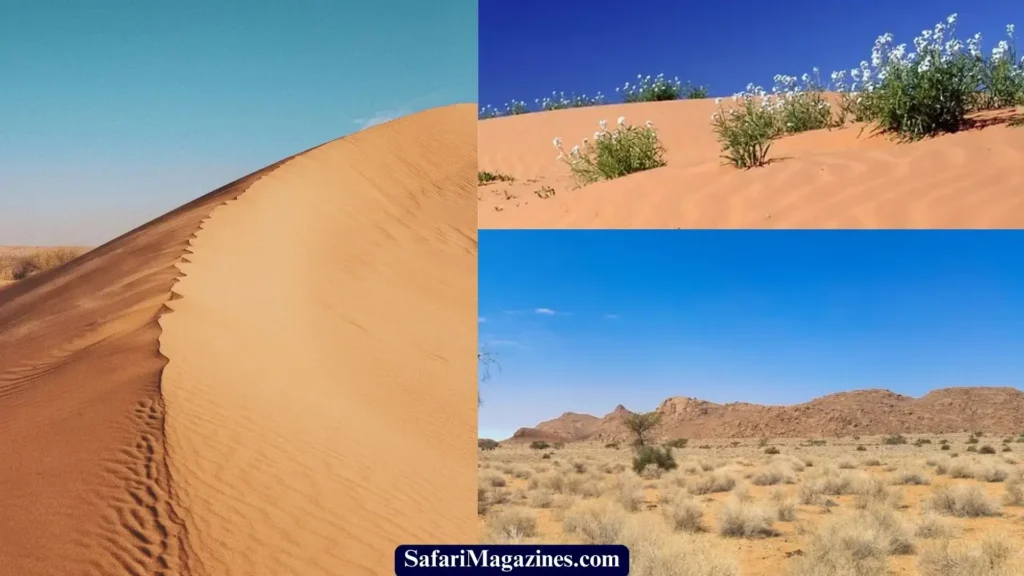
Located in South Australia, the Munga-Thirri Simpson Desert National Park covers a vast area more than 36,000 sq.-km making it Australia’s Largest National park. It extended through the Northern Territory to Queensland. Munga-Thirri The Simpson Desert National Park was declared in 2021, putting Australia at the forefront of natural ecosystem provision. This National Park offers a chance in wilderness adventure in the Australian outback. Also, its vast red sand dunes, rare plants and tranquil atmosphere create a wonderful feeling of being alone in nature.
Best Time to Visit Munga-Thirri Simpson Desert National Park:
The best time to visit Munga-Thirri Simpson Desert National Park is during the cooler months of autumn and spring (March to May and September to November). Many recommend visiting it from April to September. At this time, temperatures are moderate and more comfortable for outdoor activities.
Note: Keep in mind that even during these months, daytime temperatures can still be quite warm, so it’s essential to come prepared with plenty of water, sunscreen, and appropriate clothing. Additionally,
Wildlife of Animals and Plants:
The park is home to many wildlife like red kangaroos, dingoes, and emus, as well as reptiles like the thorny devil lizard and the bearded dragon. You’ll also find interesting plants such as hardy desert shrubs, desert oaks, mulga trees, and spinifex grasses.
How to Get There:
The park is in northeastern South Australia, near Birdsville, Queensland, and Marree, South Australia. Getting there can be tricky as it’s mostly accessed via unsealed roads, often requiring a four-wheel-drive vehicle.
Access to the park is via the Birdsville Track from the south or the Plenty Highway from the north. It’s important to note that the park is remote, with limited facilities and services, so visitors should be well-prepared for a wilderness adventure.
Limits and Restrictions:
- Stay in designated camping areas and tracks.
- Avoid off-road driving except on specified routes.
- Respect the rules against hunting, fishing, or collecting plants and animals.
- Open fires are usually not allowed, especially during high fire danger periods.
- Obtaining necessary permits for camping and driving in the desert.
Recommendations:
- Bring plenty of water, wear protective clothing, and pack essentials like food, fuel, and a first aid kit.
- Check road conditions and weather forecasts before setting off.
- Carrying adequate supplies and emergency equipment.
- Respect the desert environment by staying on tracks, disposing of waste properly, and leaving no trace of your visit.
- Summer (December to February) can be extremely hot, with temperatures soaring above 40 degrees Celsius, making it less suitable for visiting.
- Be aware that some areas may be inaccessible during the wet season (October to March) due to flooding, so it’s best to check road conditions before planning your visit.
- Experience the awe-inspiring beauty of the desert landscape by going on a guided 4WD tour or camel trek, led by experienced local guides who can provide insights into the area’s ecology, history, and Indigenous culture.
- Marvel at the spectacular night sky, free from light pollution, and witness the brilliance of the Milky Way stretching across the vast desert expanse—a truly unforgettable experience.
Kakadu National Park
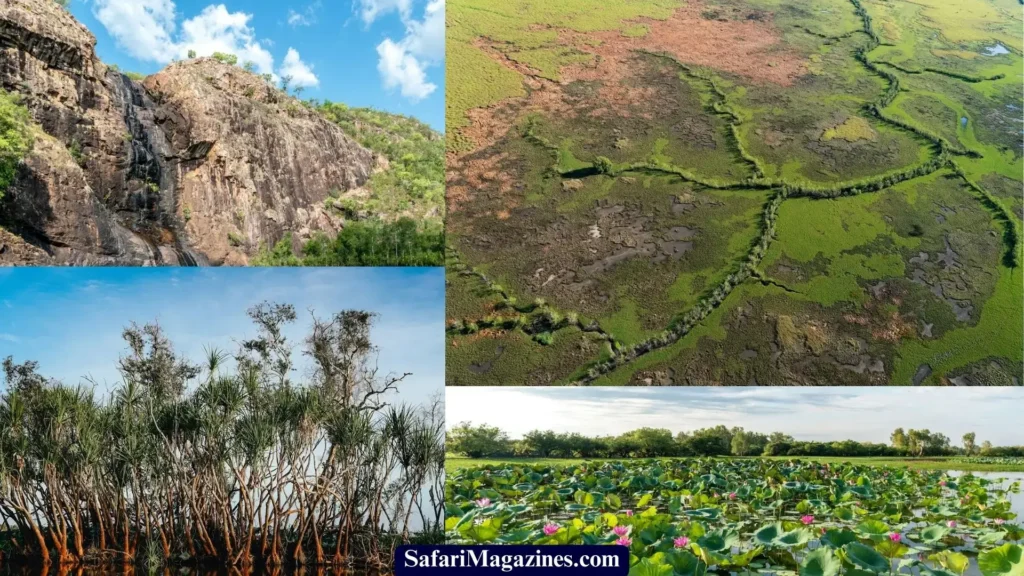
Tucked away in Australia’s rugged Northern Territory, Kakadu National Park showcases the country’s rich Indigenous heritage and natural beauty. Kakadu National Park is spanning over 20,000-sq-km. This vast wilderness is home to a stunning set of wildlife, including crocodiles, kangaroos and colorful bird species. But it’s not just the wildlife that attracts visitors to Kakadu, it’s also the park’s rich cultural significance. For thousands of years, Indigenous Australians have called this land home. They left behind a legacy of ancient rock art and sacred sites that show us their spiritual connection to the land.
Best Time to Visit Kakadu National Park:
The best time to visit Kakadu National Park is during the dry season (May to October). At this time, weather conditions are mild, and wildlife sightings are abundant.
wildlife of Animals and Plants:
Kakadu is home to many species of wildlife, including saltwater crocodiles, kangaroos, wallabies, and numerous bird species. The park also has rich of plant life, such as towering eucalyptus trees and delicate orchids.
How to Get There:
Kakadu National Park is located approximately 250 km east of Darwin. So, visitors can access the park via the Arnhem Highway and Kakadu Highway. As such, there are several entry points and visitor centers spread throughout the area.
Limits and Restrictions:
Visitors to Kakadu National Park must purchase a park pass (entrance ticket). Which helps fund conservation efforts and visitor facilities. Certain areas of the park may be subject to seasonal closures or restricted access. This happens due to cultural restrictions or conservation reasons.
Recommendations:
- Take a guided boat cruise along the park’s waterways to spot crocodiles and birdlife.
- Visit Ubirr or Nourlangie Rock to view ancient Aboriginal rock art dating back thousands of years.
Purnululu National Park
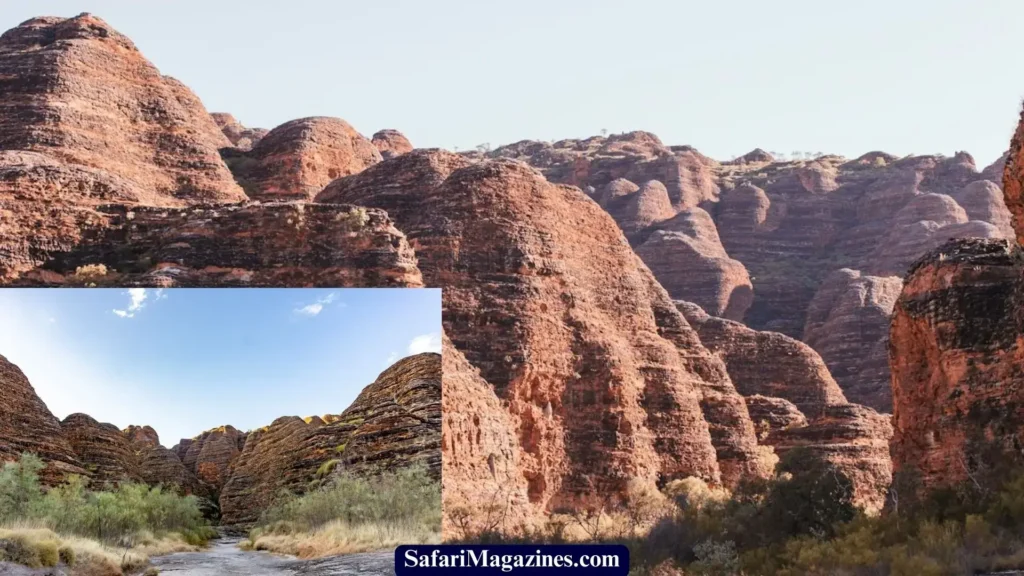
Hidden deep within the rugged landscapes of Western Australia lies Purnululu National Park. It’s home to one of Australia’s most iconic natural landmarks: the Bungle Bungle Range. Purnululu National Park is covering an area over 2,400-sq-km. So, this unique geological formation, with its distinctive striped sandstone domes, has captivated visitors for centuries. Which earned it a suitable place as a UNESCO World Heritage site. In addition to Purnululu’s famous rock formations, It is also rich in rare species of wildlife. For example, the black-footed rock-wallaby and Gouldian finch. They all call this park home.
Best Time to Visit Purnululu National Park:
The best time to visit Purnululu National Park is during the dry season (April to September). Because at this time, weather conditions are mild, and road access is more reliable.
wildlife of Animals and Plants:
Purnululu is home to a variety of wildlife, including wallabies, dingoes, and numerous bird species. The park is also famous for its unique plants, including the iconic Bungle Bungle Range.
How to Get There:
Purnululu National Park is located in the Kimberley region of Western Australia, approximately 250 kilometers south of Kununurra. Access to the park is via the Great Northern Highway and a 53-kilometer unsealed road.
Limits and Restrictions:
Visitors to Purnululu National Park must purchase a park pass (entrance ticket). This helps fund conservation efforts and visitor facilities. Due to the park’s remote location, limited in facilities, and the advise to visitors is to prepare themselves with adequate supplies.
Recommendations:
- Take a scenic flight over the Bungle Bungle Range for a bird’s-eye view of this natural wonder.
- Explore the park’s network of hiking trails, including the iconic Cathedral Gorge and Piccaninny Creek.
Continue reading: Australia’s Largest National Parks : Exploring the Wilderness from Coast to Desert
Franklin-Gordon Wild Rivers National Park
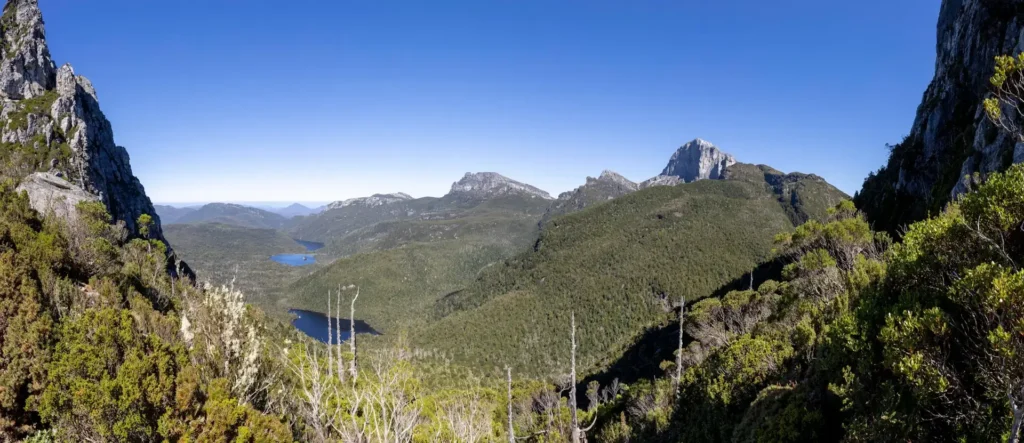
Located in the heart of Tasmania’s wilderness, Franklin-Gordon Wild Rivers National Park is perfect for outdoor enthusiasts and nature lovers. It covers an area over 4,440 sq.km. It has rugged terrain, pure rivers, and large rainforests. All this offers a an idea of the untamed beauty of the Tasmanian wilderness. Adventure-seekers flock to the park to brave the challenging rapids of the Franklin River. They can also explore the countless hiking trails that wind their way through the dense forest.
Best Time to Visit Franklin-Gordon Wild Rivers National Park:
The best time to visit Franklin-Gordon Wild Rivers National Park is during the summer months (December to February). At this time, the weather is warmer and ideal for outdoor activities such as rafting and hiking. However, prepare yourself for the possibility of rain showers and high water levels in the rivers.
wildlife of Animals and Plants:
The park is home to a diverse range of wildlife, including platypuses, Tasmanian devils, and quolls. Birdwatchers will delight in spotting endemic species such as the pink robin and the Tasmanian wedge-tailed eagle. The ancient rainforests are adorned with a many of plant species. This includes towering eucalyptus trees, ancient myrtles, and delicate ferns.
How to Get There:
Franklin-Gordon Wild Rivers National Park is located in the remote wilderness of western Tasmania. It’s about a 2-3 hour drive from Hobart or Launceston. So, the park is accessed via the Lille Motorway (A10), which passes through the heart of the park. This provides access to the main attractions
Limits and Restrictions:
Visitors should be aware that the park’s rugged terrain and remote location can present real challenges. This includes limited cell phone reception and unpredictable weather conditions. So. It is advisable to check road and weather conditions before going on your trip, carry essential supplies and emergency equipment.
Recommendations:
- Take a scenic cruise along the Gordon River, immersing yourself in the pristine beauty of the wilderness.
- Explore the park’s network of hiking trails, including the popular Franklin River Nature Trail and the challenging Frenchman’s Cap Trail. This offers amazing panoramic views of the surrounding landscape.
Uluru-Kata Tjuta National Park
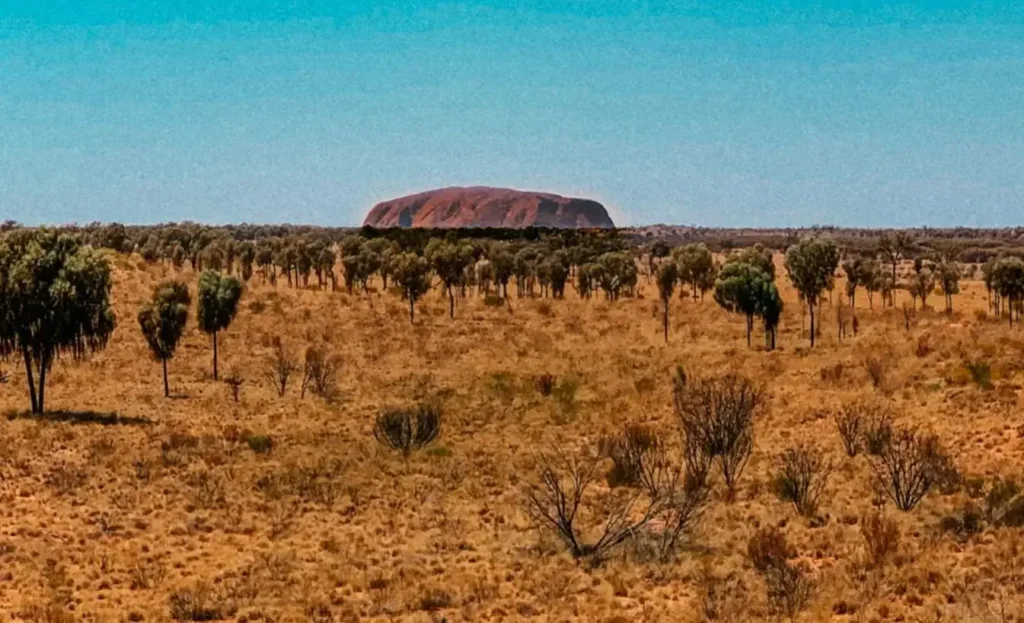
Uluru-Kata Tjuta National Park in the heart of Australia’s red centre. It is home to two of the country’s most famous natural landmarks: Uluru and Kata Tjuta. This National Park’s area is over 1,320 sq.km. These towering rock formations hold enormous cultural significance for the local Anangu people. They have inhabited this land for thousands of years. So, visitors to the park can take guided tours led by indigenous rangers. As a result, they will learn about traditional Dreamtime stories that blend with the natural world.
Best Time to Visit Uluru-Kata Tjuta National Park:
The best time to visit Uluru-Kata Tjuta National Park is during the cooler months of April to September. At this time, temperatures are milder and more comfortable for outdoor activities. However, prepare yourself for cold nights, especially in the winter months, and dress accordingly.
wildlife of Animals and Plants:
Despite the harsh desert environment, Uluru-Kata Tjuta National Park is home to a surprising variety of plant and animal life. Visitors may encounter red kangaroos, wallabies, and emus, as well as reptiles such as the thorny devil and the centralian blue-tongued lizard. The park includes hardy desert plants such as spinifex, desert oaks, and mulga trees.
How to Get There:
Uluru-Kata Tjuta National Park is located in the heart of the Australian Outback, approximately 335 kilometers southwest of Alice Springs. Therefore, the park can be accessed via the Stuart and Lasseter Highways, with the nearest major airport located in Alice Springs.
Limits and Restrictions:
Visitors must purchase an entry card to the park upon arrival. Which contributes to the ongoing preservation and management of the park. Certain areas of the park, including Uluru itself, are considered sacred sites by the local Anangu indigenous people. So this may be subject to cultural restrictions or closures.
Recommendations:
- Experience the breathtaking sunrise or sunset over Uluru, a truly unforgettable sight.
- Take a guided tour with an Indigenous ranger to learn about the cultural significance of Uluru and Kata Tjuta and gain a deeper understanding of the land and its people.
Continue reading: Australia’s Largest National Parks : Exploring the Wilderness from Coast to Desert
Gondwana Rainforests
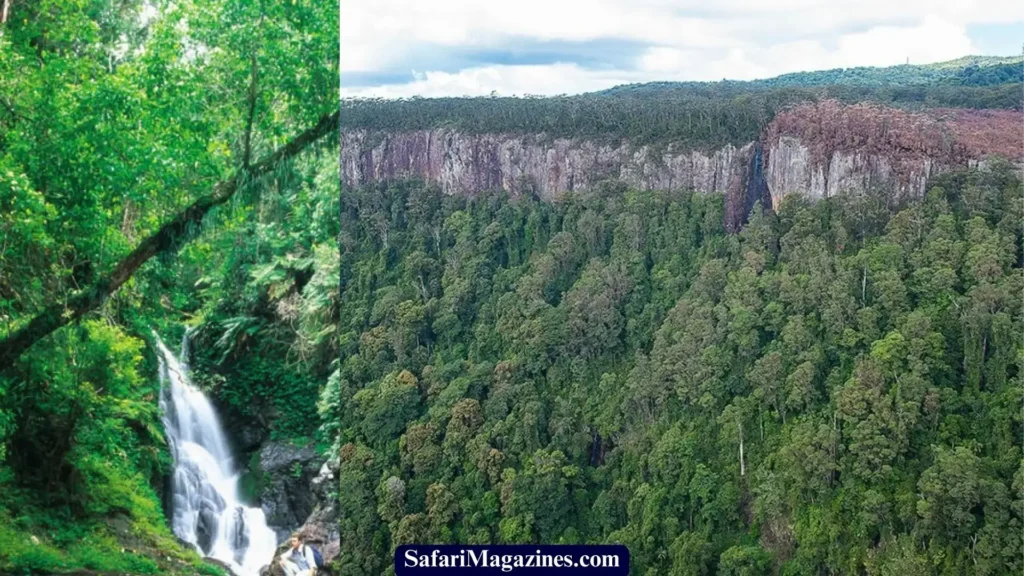
Stretching across the eastern coast of Australia, the Gondwana rainforests are proof of the continent’s ancient past. This UNESCO World Heritage-listed site is home to some of the oldest rainforests on Earth. This is because its plant species, which dating back millions of years. So, visitors to the park can explore a lush green landscape teeming with life, from towering ferns to rare marsupials like the elusive platypus.
Best Time to Visit Gondwana Rainforests:
The best time to visit the Gondwana Rainforests is during the cooler, drier months of autumn and spring (March to May and September to November). During these times, the weather is mild and rainfall is minimal. This makes it ideal for exploring rainforest trails and enjoying outdoor activities.
wildlife of Animals and Plants:
The Gondwana Rainforests are home to an incredibly diverse range of plant and animal species. Many of which are found nowhere else on Earth. Visitors can see ancient Antarctic beech trees, towering hoop pines, and delicate orchids, as well as rare and endangered species such as Albert’s lyrebird and Richmond’s birdwing butterfly.
How to Get There:
The Gondwana Rainforests span multiple locations across eastern Australia, including parts of New South Wales and Queensland. So, major access points include Lamington National Park, Border Ranges National Park, and Dorrigo National Park. All of which are accessible by car from nearby towns and cities.
Limits and Restrictions:
While exploring the Gondwana Rainforests, visitors are encouraged to stay on designated walking tracks and follow park regulations to minimize their impact on the delicate ecosystem. Some areas may be subject to temporary closures or restricted access due to conservation efforts or maintenance work.
Recommendations:
- Take a guided eco-tour to learn about the unique plants and animals of the rainforest. Also get an insight into the conservation efforts underway to protect this World Heritage-listed area.
- Spend a night in a cozy rainforest retreat or eco-lodge to experience the magic of the rainforest after dark and listen to the symphony of nocturnal wildlife.
Great Barrier Reef Marine Park
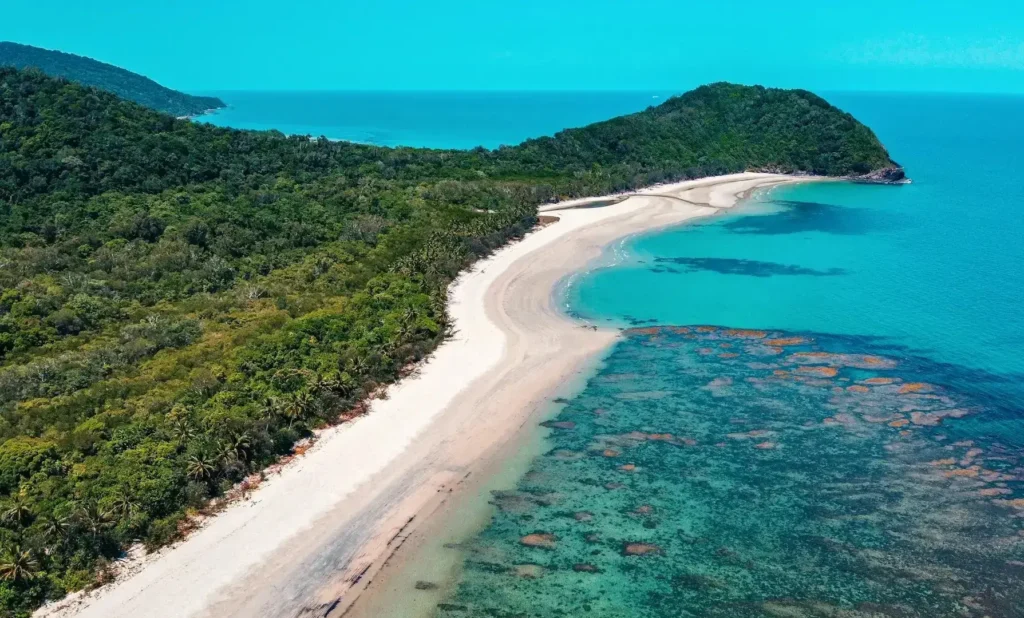
No exploration of Australia’s natural wonders would be complete without a visit to the Great Barrier Reef Marine Park. Its area is more than 344,400-sq-km. This National Park also extends more than 2,300 kilometers along the Queensland coast. Its underwater area is home to a dazzling array of marine life, including colorful coral reefs, tropical fish, and majestic sea turtles. But the reef faces numerous threats such as climate change and pollution. This highlights the importance of conservation efforts to protect this sensitive ecosystem for future generations.
Best Time to Visit Great Barrier Reef Marine Park:
The best time to visit the Great Barrier Reef Marine Park is during the dry season (May to October). At this time, weather conditions are moderate, and visibility is ideal for snorkeling and diving. However, the reef is a year-round destination, with plenty to see and do at any time of year.
wildlife of Animals and Plants:
The Great Barrier Reef is home to an astonishing set of marine life, including colorful coral reefs, tropical fish, sea turtles, sharks, and rays. Visitors can also spot whales, dolphins, and dugongs, as well as an abundance of seabirds. The reef’s diverse ecosystem supports over 1,500 species of fish and 400 species of coral, making it one of the most biodiverse marine environments on the planet.
How to Get There:
The Great Barrier Reef Marine Park stretches over 2,300 kilometers along the coast of Queensland, from the tip of Cape York Peninsula to the southern city of Bundaberg. So, access to the reef is available from various coastal towns and cities. This including Cairns, Port Douglas, and the Whitsunday Islands, with numerous tour operators offering snorkeling, diving, and boat trips.
Limits and Restrictions:
Visitors to the Great Barrier Reef Marine Park are required to follow strict guidelines to protect the fragile ecosystem. This including refraining from touching or damaging coral, avoiding littering, and using reef-safe sunscreen. Certain areas of the reef may be designated as no-entry zones or marine sanctuaries to protect sensitive habitats and species.
Recommendations:
- Explore the reef’s underwater world on a snorkeling or scuba diving adventure. This is done under the guidance of experienced marine experts who can point out hidden treasures and unique sea creatures.
- Take a scenic helicopter or seaplane flight over the reef to appreciate its vast size and stunning beauty from above. So, this is with opportunities to discover marine life, secluded islands and coral cays.
Continue reading: Australia’s Largest National Parks : Exploring the Wilderness from Coast to Desert
Blue Mountains National Park
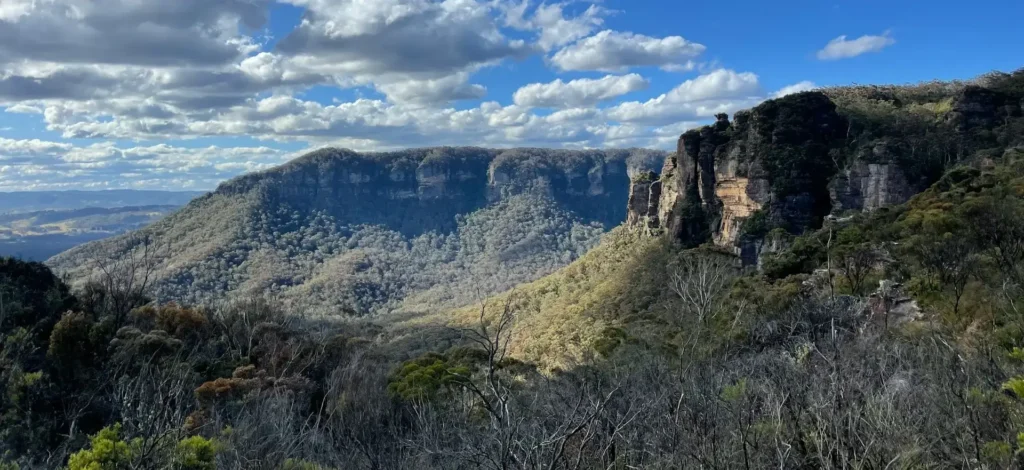
Just a short drive from the bustling metropolis of Sydney lies the serene wilderness of Blue Mountains National Park. Its area is more than 2680 sq.-km. This National Park is Named for the distinctive blue haze that envelops the towering eucalyptus forests. So, this park is a paradise for hikers, rock climbers, and nature lovers. Visitors can explore scenic lookouts that offer panoramic views of the rugged cliffs and deep valleys below. They can also go on one of the park’s many hiking trails, making their way through ancient rainforests and waterfalls.
Best Time to Visit Blue Mountains National Park:
The best time to visit Blue Mountains National Park is during the cooler months of autumn and spring. This means from (March to May and September to November). During these times, the temperatures are mild, and rainfall is minimal. Summer (December to February) can also be enjoyable, but prepare yourself for higher temperatures and potential crowds.
wildlife of Animals and Plants:
Blue Mountains National Park is home to a diverse range of plant and animal species. This is including iconic Australian wildlife such as kangaroos, wallabies, and echidnas. Bird watchers will be pleased to show native bird species, such as lyrebirds, cockatoos and rosellas, while the park’s eucalypt forests are adorned with many native trees and shrubs.
How to Get There:
Blue Mountains National Park is located just a short drive from Sydney. This makes it easily accessible for day trips or weekend getaways. So, the park can be reached by car via the Great Western Highway, with numerous entry points and visitor centers scattered throughout the area.
Limits and Restrictions:
While exploring Blue Mountains National Park, visitors are encouraged to stay on designated walking tracks and follow park regulations to minimize their impact on the environment. Some areas of the park may be subject to temporary closures or restricted access due to maintenance work or conservation efforts.
Recommendations:
Take a scenic ride on the Katoomba Scenic Railway, the steepest passenger railway in the world, for breathtaking views of the Jamison Valley and Three Sisters rock formation.
Explore the park’s network of hiking trails, ranging from easy walks to challenging treks, with highlights including the Grand Canyon Track, the Wentworth Falls Circuit, and the iconic Prince Henry Cliff Walk.
Grampians National Park
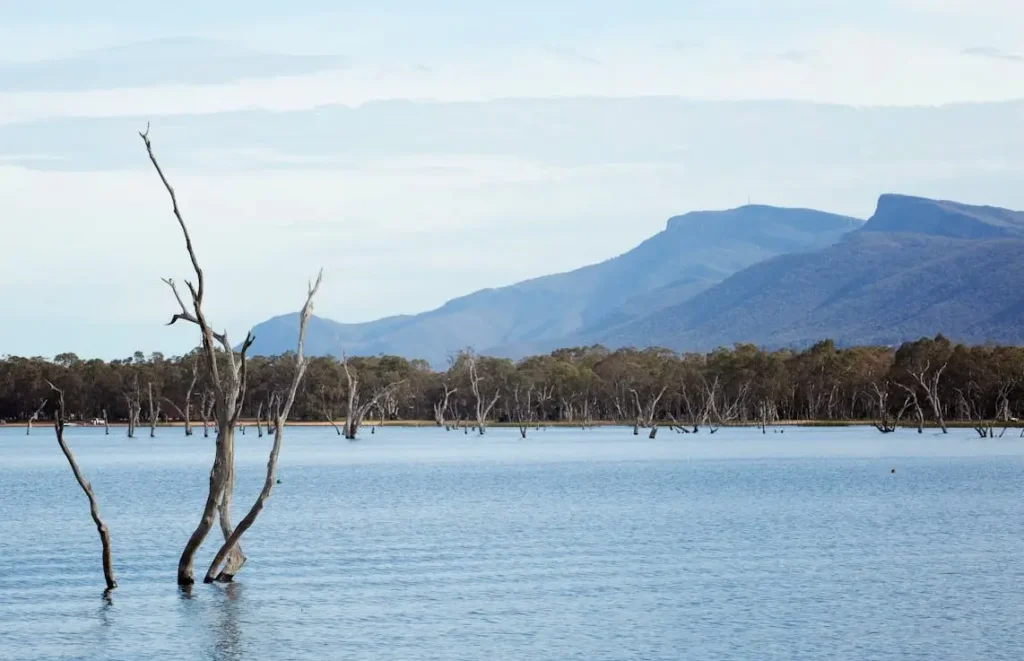
Nestled in the heart of Victoria’s rugged countryside, Grampians National Park is a playground for outdoor adventurers and nature enthusiasts. With its towering sandstone cliffs, sweeping valleys, and cascading waterfalls, this park offers a glimpse into the wild beauty of the Australian bush. So, visitors can explore ancient Aboriginal rock art sites, tackle challenging hiking trails, or simply soak in the breathtaking vistas from one of the park’s many lookout points.
Best Time to Visit Grampians National Park:
The best time to visit Grampians National Park is during the spring months (September to November). At this time, when wildflowers are in bloom, and temperatures are mild. Autumn (March to May) is also a pleasant time to visit, with cooler temperatures and beautiful autumn foliage.
wildlife of Animals and Plants:
Grampians National Park is renowned for its rugged landscapes and rich biodiversity, with an abundance of plant and animal species. Visitors may encounter kangaroos, wallabies, and koalas, as well as elusive echidnas and platypuses. The park’s sandstone cliffs and rocky outcrops are adorned with a variety of native vegetation, including wildflowers, heathland, and eucalypt forests.
How to Get There:
Grampians National Park is located approximately 260 kilometers northwest of Melbourne, making it easily accessible by car via the Western Highway. The park’s main entry points include Halls Gap, Dunkeld, and Stawell, with visitor centers providing information and facilities for visitors.
Limits and Restrictions:
Visitors to Grampians National Park are required to purchase a park entry pass, which helps fund conservation efforts and visitor facilities. Some areas of the park may be subject to seasonal closures or restricted access due to fire risk, cultural significance, or conservation reasons.
Recommendations:
- Take a scenic drive along the Grampians Way, stopping at lookout points and scenic attractions such as the Balconies, MacKenzie Falls, and Boroka Lookout.
- Explore the park’s network of hiking trails, ranging from short walks to multi-day treks, with highlights including the Pinnacle Walk, the Wonderland Loop, and the challenging Mt. William Summit Track.
Continue reading: Australia’s Largest National Parks : Exploring the Wilderness from Coast to Desert
Daintree National Park
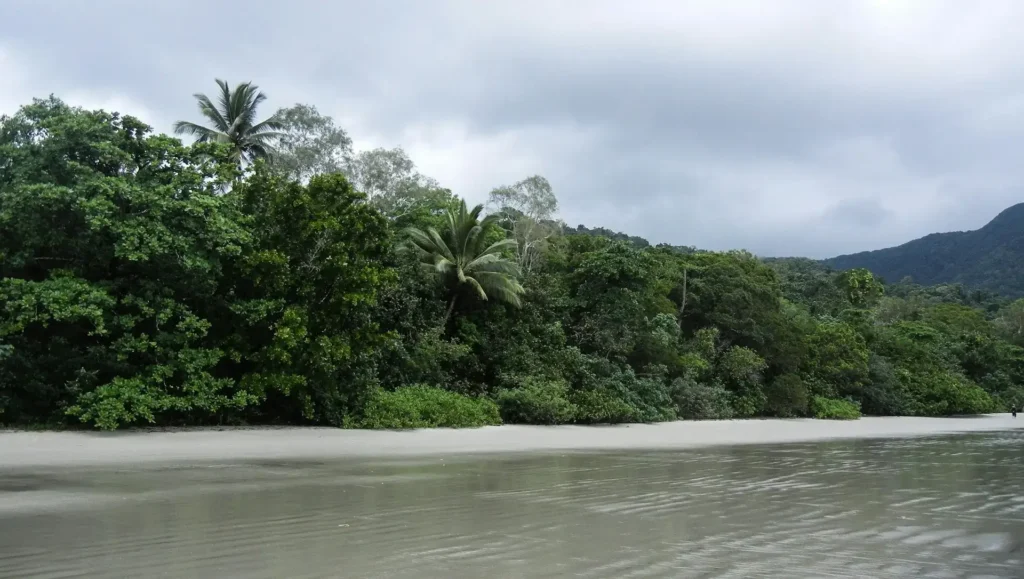
Venture into the heart of Far North Queensland, and you’ll discover the ancient rainforests of Daintree National Park. Dating back over 180 million years, these lush, verdant landscapes are home to an incredible diversity of plants and animals. This includes rare species like the southern cassowary and the prehistoric-looking Boyd’s forest dragon. Visitors can explore the park’s network of hiking trails, cruise along the Daintree River in search of crocodiles. They also can take a guided tours led by local Indigenous guides.
Best Time to Visit Daintree National Park:
The best time to visit Daintree National Park is during the dry season (May to October). At this time, weather is mild, and rainfall is minimal. this makes it ideal for exploring the rainforest and enjoying outdoor activities. However, the park is a year-round destination, with plenty to see and do at any time of year.
Wildlife of Animals and Plants:
Daintree National Park is home to an incredible diversity of plants and animals. This is including ancient rainforest species and unique wildlife found nowhere else on Earth. Visitors may encounter cassowaries, tree kangaroos, and colorful butterflies, as well as rare and endangered plants such as the Daintree pine and the Bennett’s tree-kangaroo.
How to Get There:
Daintree National Park is located in Far North Queensland, approximately 100 kilometers north of Cairns. The park can be accessed via the Captain Cook Highway and the Daintree River Ferry. With several entry points and visitor centers providing information and facilities for visitors.
Limits and Restrictions:
While exploring Daintree National Park, visitors are encouraged to stay on designated walking tracks and follow park regulations to minimize their impact on the fragile ecosystem. Some areas of the park may be subject to temporary closures or restricted access due to conservation efforts or maintenance work.
Recommendations:
- Take a guided tour with a local Indigenous guide to learn about the cultural significance of the rainforest and gain insights into traditional Aboriginal practices and customs.
- Explore the park’s network of hiking trails, including the popular Mossman Gorge Circuit and the challenging Mount Sorrow Ridge Trail, for opportunities to spot wildlife and enjoy the beauty of the rainforest.
Freycinet National Park
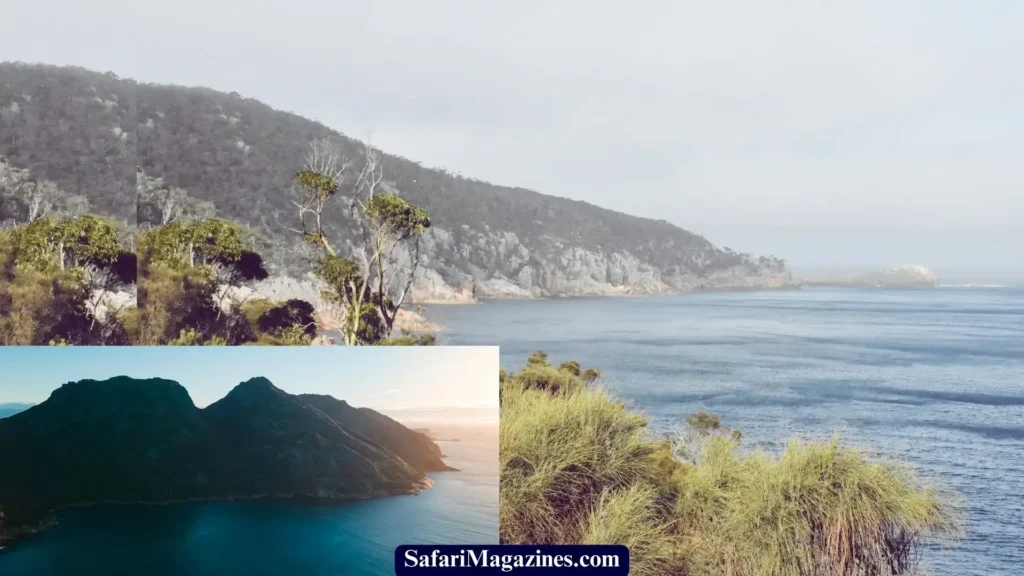
Tucked away on Tasmania’s stunning east coast lies Freycinet National Park, home to some of the state’s most breathtaking landscapes. From the pristine white sands of Wineglass Bay to the rugged granite peaks of the Hazards Range, this park offers something for every outdoor enthusiast. Visitors can spend their days swimming, snorkeling, and kayaking in the crystal-clear waters or go on scenic hikes to secluded beaches and panoramic lookout points.
Best Time to Visit Freycinet National Park:
- The best time to visit Freycinet National Park is during the spring and autumn months. This means from (September to November and March to May). At this time, temperatures are mild, and rainfall is minimal, making it perfect for adventures in nature like hiking and kayaking. Summer (December to February) can be hot and crowded, so consider visiting outside of peak season for a more tranquil experience.
Wildlife of Animals and Plants:
Freycinet National Park is home to a diverse range of plants and animals. This is including unique plant species and iconic Australian wildlife. Visitors may encounter echidnas, pademelons, and wallabies, as well as bird species such as the endangered swift parrot and the Tasmanian native hen. The park’s coastal heathlands are adorned with a variety of native shrubs and wildflowers, including the distinctive pink granite cliffs of the Hazards Range.
How to Get There:
Freycinet National Park is located on Tasmania’s stunning east coast, approximately 190 kilometers northeast of Hobart. The park can be accessed by car via the Tasman Highway and the Coles Bay Road, with several entry points and visitor centers providing information and facilities for visitors.
Limits and Restrictions:
Visitors to Freycinet National Park are required to purchase a park entry pass, which helps fund conservation efforts and visitor facilities. Some areas of the park, including Wineglass Bay, may be subject to visitor limits or temporary closures during peak times to manage congestion and protect sensitive habitats.
Recommendations:
- Take a scenic hike to Wineglass Bay Lookout for panoramic views of one of the world’s most beautiful beaches, then descend to the pristine sands below for a refreshing swim or picnic.
- Explore the park’s network of walking trails, including the Freycinet Peninsula Circuit and the Mount Amos Trail, for opportunities to spot wildlife and immerse yourself in the natural beauty of the coastline and surrounding mountains.
Continue reading: Australia’s Largest National Parks : Exploring the Wilderness from Coast to Desert
Litchfield National Park
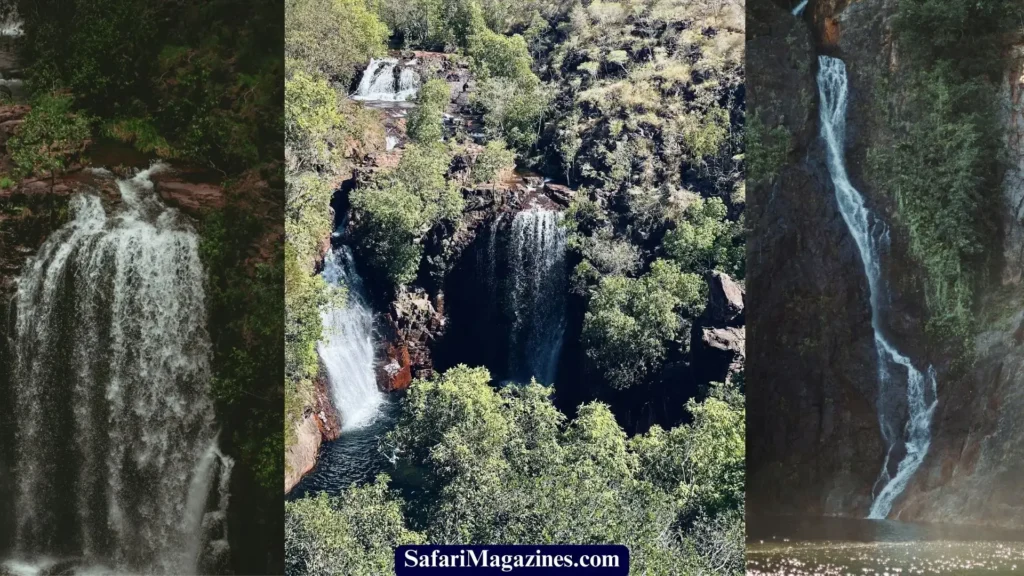
Escape the noise of city life and enjoy the tranquility and natural beauty of Litchfield National Park. Litchfield National Park is covering an area over 1500-sq-km. Located just a short drive from Darwin in Australia’s Northern Territory, this park is famous for its stunning waterfalls, tranquil swimming holes, and unique magnetic termite mounds. So, visitors can cool off in the refreshing waters of Florence Falls, marvel at the towering cathedral termite mounds, or explore the park’s network of walking trails that wind through lush monsoon forests.
Best Time to Visit Litchfield National Park:
The best time to visit Litchfield National Park is during the dry season (May to September). At this time, weather conditions are mild, and rainfall is minimal, making it ideal for exploring the park’s waterfalls, swimming holes, and walking trails. However, the park is a year-round destination, with plenty to see and do at any time of year.
Wildlife of Animals and Plants:
Litchfield National Park is home to a diverse range of animals and plants, including iconic Australian wildlife such as wallabies, possums, and flying foxes. Visitors may encounter freshwater crocodiles and numerous bird species, as well as unique plant species such as the Darwin woollybutt and the Litchfield box. The park’s landscapes are adorned with towering termite mounds, cascading waterfalls, and lush monsoon forests.
How to Get There:
Litchfield National Park is located about 100 kilometers southwest of Darwin in the Northern part of Australia. So, the park can be accessed by car via the Stuart Highway and the Batchelor and Litchfield Park Roads, with several entry points and visitor centers providing information and facilities for visitors.
Limits and Restrictions:
While exploring Litchfield National Park, visitors are encouraged to stay on designated walking tracks and follow park regulations to minimize their impact on the environment. So, swimming in certain waterholes may be restricted due to safety concerns or cultural reasons, so be sure to check for signage and follow any advice from park rangers.
Recommendations:
- Take a refreshing dip in the crystal-clear waters of Florence Falls or Wangi Falls, surrounded by lush rainforest and towering cliffs, for a memorable swimming experience.
- Explore the park’s network of walking trails, including the popular Tabletop Track and the challenging Tjaetaba Falls Trail, for opportunities to spot wildlife and enjoy the natural beauty of the park.
Continue reading: Australia’s Largest National Parks : Exploring the Wilderness from Coast to Desert
Flinders Ranges National Park
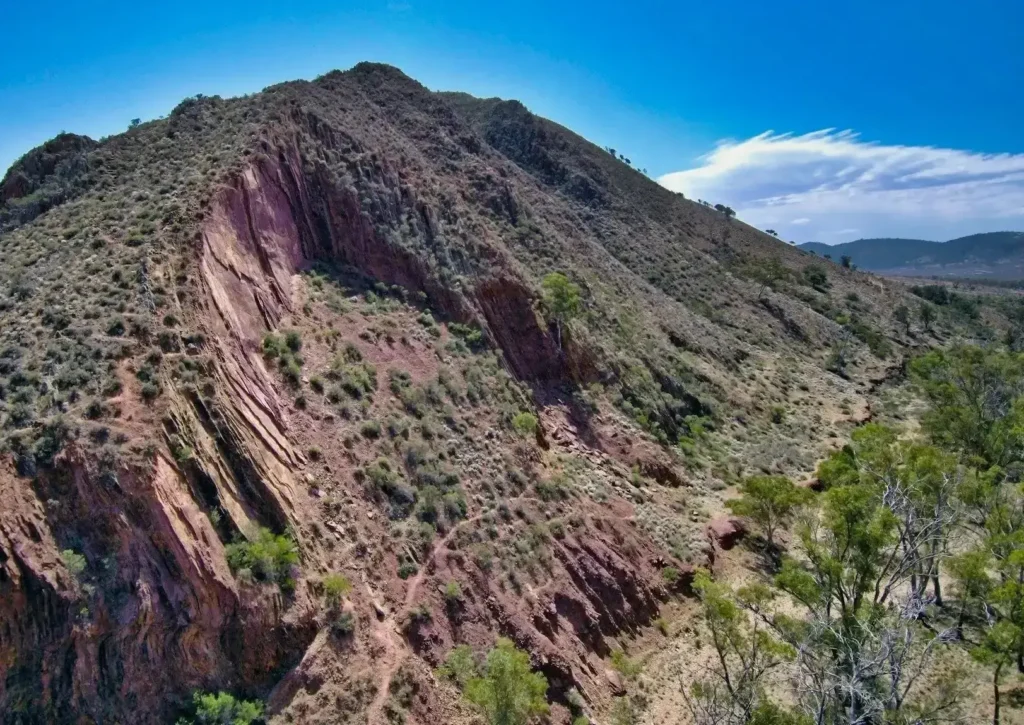
Journey to the heart of South Australia’s outback, and you’ll discover the rugged beauty of Flinders Ranges National Park. It is covering an area more than 950 sq.-km. Characterized by its ancient landscapes, dramatic gorges, and sprawling plains, this park offers a glimpse into the geological and cultural history of the region. So, visitors can explore the park’s network of hiking trails, marvel at ancient Aboriginal rock art sites. They also can go on a scenic flight over Wilpena Pound, a natural amphitheater nestled amidst the rugged peaks of the Flinders Ranges.
Best Time to Visit Flinders Ranges National Park:
The best time to visit Flinders Ranges National Park is during the cooler months of autumn and spring. This means from (March to May and September to November), when temperatures are mild, and wildflowers are in bloom. Summer (December to February) can be extremely hot, so it’s best to visit during the cooler months for a more comfortable experience.
wildlife of Animals and Plants:
Flinders Ranges National Park is home to a diverse range of plants and animals adapted to the arid outback environment. Visitors may encounter kangaroos, emus, and wedge-tailed eagles, as well as reptiles such as the bearded dragon and the centralian carpet python. The park’s rugged landscapes are adorned with iconic native plants such as the river red gum, the Sturt’s desert pea, and the iconic pound-forming cliffs of Wilpena Pound.
How to Get There:
Flinders Ranges National Park is located approximately 450 kilometers north of Adelaide in South Australia. The park can be accessed by car via the Augusta Highway and the Hawker-Stirling North Road, with several entry points and visitor centers providing information and facilities for visitors.
Limits and Restrictions:
While exploring Flinders Ranges National Park, visitors are encouraged to stay on designated roads and walking tracks and follow park regulations to minimize their impact on the environment. Camping is permitted in designated campgrounds and bush campsites, with fees and bookings required for some areas.
Recommendations:
- Take a scenic drive along the Flinders Ranges Way, stopping at lookout points and scenic attractions such as Stokes Hill Lookout, Brachina Gorge, and the historic town of Blinman.
- Explore the park’s network of hiking trails, including the challenging St. Mary Peak Trail and the scenic Bunyeroo Gorge Walk, for opportunities to spot wildlife and enjoy the rugged beauty of the outback.
Summary
Australia’s National Parks offer views of the natural wonders of the stunning landscapes and unique ecosystems that make Australia truly special. These also play an important role in conservation efforts, preserving these unique ecosystems for future generations. So, pack your bags, lace up your hiking boots, and go on an unforgettable adventure journey to explore the untamed beauty of Australia’s national parks.
Related topics:
- Exploring the World’s Biggest National Parks: Unveiling Nature’s Grandeur
- Unearth China’s Largest National Parks: Discovering Nature’s Grandeur
- Exploring the Largest National Parks in Asia
- The Largest National Parks in the United States of America: Natural Treasures of the USA
- Discover the Largest National Parks in Europe: Exploring Nature and Wild Landscapes
- Into the Wild: Africa’s Largest National Parks Await Your Discovery
- Exploring Earth’s Largest National Parks by Continent: Discover the World’s Wild Wonderlands
FAQs about Australia’s National Parks
Q1: Are Australia’s national parks safe to visit?
A1: Yes, Australia’s national parks are generally safe to visit, but it’s essential to be aware of potential hazards like extreme weather conditions and wildlife encounters. Always follow park regulations and advice from park rangers to ensure a safe and enjoyable visit.
Q2: Are Australia’s largest national parks suitable for family visits?
A2: Absolutely! Many of Australia’s largest national parks offer family-friendly activities such as guided tours, easy walking trails, and designated picnic areas. Just be sure to check for any age restrictions or safety guidelines before planning your visit.
Q3: Are Australia’s national parks accessible for people with disabilities?
A3: While accessibility varies from park to park, many national parks in Australia offer facilities and services for visitors with disabilities, such as accessible trails, wheelchair-friendly amenities, and inclusive tour options. It’s always a good idea to check with park authorities or visitor centers for specific accessibility information before planning your trip.
Q4: Are pets allowed in Australia’s national parks?
A4: In most cases, pets are not allowed in Australia’s national parks to protect native wildlife and preserve fragile ecosystems. However, some parks may allow pets in designated areas or on specific walking trails, provided they are kept on a leash and their waste is properly disposed of. Be sure to check for pet policies and restrictions before bringing your furry friend along.
Q5: Are camping facilities available in Australia’s national parks?
A5: Yes, many of Australia’s national parks offer camping facilities ranging from basic bush campsites to fully-equipped campgrounds with amenities like showers and toilets. Be sure to check the park’s website or contact park authorities for information on camping options and reservations.
